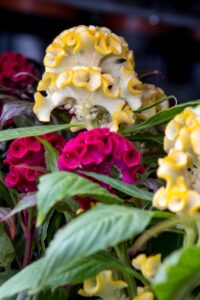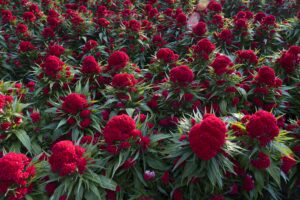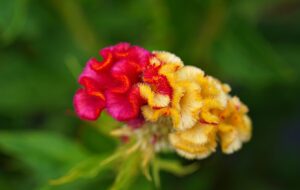Cockscomb, scientifically known as Celosia argentea var. cristata, is not only a stunning addition to gardens and landscapes but also an excellent choice for cut flower arrangements. Known for its vibrant, velvety blooms that resemble the comb of a rooster, cockscomb adds a unique touch of color, texture, and drama to bouquets, centerpieces, and floral designs.
With its distinctive crested flower heads that come in shades of red, orange, yellow, and pink, cockscomb makes a bold statement in any arrangement. The densely packed, ruffled blooms are long-lasting and hold up well both in fresh arrangements and when dried, making them versatile for various floral projects.

As a cut flower, cockscomb is prized for its ability to add volume and texture to arrangements. Its sturdy stems and vibrant colors make it a standout choice for mixed bouquets or as a focal point in floral designs. Additionally, cockscomb is relatively easy to grow and maintain, making it accessible for home gardeners and professional florists alike.
Whether used fresh or dried, cockscomb brings a touch of whimsy and sophistication to any floral creation. Its bold presence and unique appearance make it a favorite among flower enthusiasts looking to make a statement with their arrangements.
Sunlight Requirement
Cockscomb flowers thrive in full sunlight. They require at least 6 to 8 hours of direct sunlight each day to grow and bloom to their full potential. Adequate sunlight ensures robust growth, vibrant flower color, and sturdy stems.
Temperature and Humidity Requirement of Cockscomb Flower
Cockscomb flowers thrive in warm temperatures and moderate humidity levels. Cockscomb flowers prefer temperatures between 70°F to 85°F (21°C to 29°C) during the day and slightly cooler temperatures at night. They are sensitive to cold temperatures and frost, so it’s essential to plant them after the last frost date in your area. In cooler climates, growing as an annual during the warmer months is ideal. While cockscomb can tolerate average humidity levels, they prefer moderate humidity ranging from 40% to 60%.
Soil Requirement
Cockscomb flowers thrive in well-draining soil with a slightly acidic to neutral pH level (around 6.0 to 7.0). Sandy loam or loamy soil types are ideal as they provide adequate drainage while retaining some moisture.

Seed Sowing
Cockscomb flowers can be propagated through seed sowing for cut flower production. Here’s a step-by-step guide on how to propagate cockscomb flowers from seeds:
Choose high-quality cockscomb flower seeds from a reputable supplier. Look for seeds of the desired variety or cultivar, as cockscomb flowers come in various colors and forms, including plumed, crested, and spiky varieties.
Cockscomb flowers are warm-season annuals that prefer warm temperatures for germination and growth. Start seeds indoors 6 to 8 weeks before the last frost date in your area, or sow seeds directly outdoors after the danger of frost has passed and the soil has warmed up.
Use seed trays, cell packs, or small pots filled with a well-draining seed starting mix. Moisten the mix before planting to ensure good seed-to-soil contact.
Plant seeds on the soil surface, pressing them lightly into the soil or covering them with a thin layer of seed starting mix. Space seeds evenly in the container, allowing room for seedlings to develop.
Cockscomb seeds require light for germination, so do not cover them with soil. Place the seed trays in a warm, bright location with indirect sunlight or under grow lights. Maintain a temperature of around 70-75°F (21-24°C) for optimal germination.
Keep the seed starting mix evenly moist but not waterlogged. Water gently using a misting spray bottle or a watering can with a fine rose attachment to avoid disturbing the seeds.
Cockscomb seeds typically germinate within 7 to 14 days under ideal conditions. Once seedlings emerge, provide good air circulation to prevent damping off, a fungal disease that affects seedlings.
When seedlings have developed a few true leaves and are large enough to handle, transplant them into individual pots or cell packs filled with potting soil. Harden off seedlings by gradually exposing them to outdoor conditions before transplanting them into the garden.
Prepare the garden bed by amending the soil with compost or aged manure to improve fertility and drainage. Choose a sunny location with well-drained soil for planting cockscomb flowers.
Transplant seedlings into the garden after the last frost date, spacing them 8-12 inches apart depending on the variety. Water seedlings well after planting to help them establish roots.
By following these steps, you can successfully propagate flowers from seeds for cut flower production and enjoy a beautiful display of vibrant blooms in your garden.
Water Requirement
Cockscomb flowers prefer consistently moist soil. Water the plants regularly to keep the soil evenly moist, but not waterlogged. Avoid allowing the soil to dry out completely between waterings, as this can stress the plants and reduce flower production. When possible, water cockscomb plants at the base to avoid wetting the foliage.

Problems While Growing Cockscomb Flower
While cockscomb flowers can make stunning additions to cut flower arrangements, there are several potential problems you may encounter when growing them for this purpose. Here are some common issues and tips on how to address them:
Disease susceptibility: Cockscomb flowers can be susceptible to fungal diseases such as powdery mildew, leaf spot, and damping off. To prevent these diseases, avoid overhead watering, which can promote fungal growth. Provide good air circulation by spacing plants adequately and removing any crowded or diseased foliage. Additionally, consider using fungicides labeled for ornamental plants if disease problems persist.
Pest infestations: Aphids, spider mites, and thrips are common pests that can affect cockscomb flowers. Monitor plants regularly for signs of pest infestations, such as distorted leaves, stippling, or the presence of insects. Insecticidal soap, neem oil, or other insecticides labeled for ornamental use can help control pest populations.
Poor flowering: Several factors can lead to poor flowering in cockscomb plants, including inadequate sunlight, nutrient deficiencies, and environmental stress. Ensure that plants receive full sun for at least 6-8 hours per day to promote abundant flowering. Fertilize plants periodically with a balanced fertilizer to provide essential nutrients for growth and flowering. Avoid overfertilizing, as this can lead to excessive foliage growth at the expense of flowers.
Wilting or drooping flowers: Cockscomb flowers may wilt or droop prematurely if they are not adequately hydrated or if they are cut too early in the morning when they are not fully hydrated. Harvest flowers for cut arrangements early in the morning or late in the evening when they are well-hydrated. Immediately place cut stems in a bucket of water to prevent wilting. Re-cut the stems at an angle before arranging them in a vase to ensure maximum water uptake.
By addressing these common problems and implementing proper care practices, you can successfully grow cockscomb flowers for cut flower production and enjoy their vibrant blooms in arrangements and bouquets.
Harvesting of Cockscomb Cut Flower
Harvesting cockscomb cut flowers is a straightforward process, but timing and technique are crucial to ensuring the best quality blooms. Here’s a guide on how to harvest cockscomb cut flowers:

The best time to harvest cockscomb flowers is in the early morning or late afternoon when temperatures are cooler and the plants are well-hydrated. Avoid harvesting during the hottest part of the day, as flowers may wilt more quickly.
Look for cockscomb blooms that are fully developed and have vibrant color. The flower heads should be firm to the touch and show no signs of wilting or damage. Avoid harvesting flowers that are still in bud or have started to decline.
Before harvesting, make sure your cutting tools are clean and sharp. Dirty or dull tools can introduce bacteria and damage the stems, reducing the vase life of the flowers. Disinfect your cutting tools with rubbing alcohol or a bleach solution if necessary.
To harvest cockscomb flowers, use your scissors or pruners to make a clean, angled cut on the stem, just above a leaf node or side shoot. Cutting at an angle increases the surface area for water uptake and helps prevent the stem from resting flat on the bottom of the vase, which can impede water flow.
After harvesting the flowers, remove any foliage that will be submerged in water when arranging them in a vase. Excess foliage can rot in the water and promote bacterial growth, reducing the vase life of the flowers. Leave a few leaves near the top of the stem to help support the flower head.
After cutting the cockscomb flowers, immediately place the stems in a bucket or vase filled with clean, tepid water. This helps prevent wilting and allows the flowers to rehydrate after harvesting. If possible, recut the stems underwater to prevent air bubbles from forming in the stems, which can block water uptake.
To prolong the vase life of cockscomb flowers, consider conditioning them before arranging them in a vase. Conditioning involves submerging the stems in warm water for a few hours or overnight to allow them to fully hydrate. You can also add floral preservatives to the water to inhibit bacterial growth and extend the vase life of the flowers.
By following these harvesting tips, you can ensure that your cockscomb cut flowers are harvested at the optimal time and are ready to be enjoyed in arrangements and bouquets.


